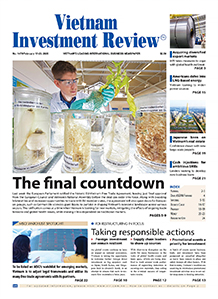Innovent updates IBI363 data in advanced lung cancer at ASCO
SAN FRANCISCO and SUZHOU, China, June 4, 2025 /PRNewswire/ -- Innovent Biologics, Inc. ("Innovent") (HKEX: 01801), a world-class biopharmaceutical company that develops, manufactures and commercializes high-quality medicines for the treatment of oncology, autoimmune, cardiovascular and metabolic, ophthalmology and other major diseases, announced the third oral presentation of clinical data for IBI363 (first-in-class PD-1/IL-2α-bias bispecific antibody fusion protein) in advanced non-small cell lung cancer at the 2025 American Society of Clinical Oncology (ASCO), following IBI363's other two oral presentations in colorectal cancer and melanoma. A manageable safety profile, encouraging efficacy, and trends in long-term survival benefits have been observed in both immunotherapy-resistant squamous non-small cell lung cancer (NSCLC) and wild-type lung adenocarcinoma. It is worth mentioning that Innovent's pipeline has a total of 8 oral presentations at this ASCO conference, representing approximately 2% of the conference's total oral presentations.
Innovent Biologics is conducting clinical studies in China, the United States, and Australia to explore the efficacy and safety of IBI363 for multiple tumor indications, including immune resistance, cold tumors, and front-line treatments. At this year's ASCO meeting, three oral presentations of IBI363 reported encouraging Phase 1/2 clinical data in the first three indications explored—NSCLC, CRC, and melanoma—focusing on IO-resistant and cold tumors. The data comprehensively demonstrated the breakthrough clinical outcomes of IBI363 across these indications, from robust tumor response to long-term survival benefits. These findings provide strong support of the drug's novel mechanism of action translating effectively into clinical outcomes, and imply its potential for broader clinical development, offering new hope in areas of immunotherapy where treatment options remain limited.
PD-1/IL-2α-bias bispecific antibody fusion protein IBI363 in patients with immunotherapy resistant advanced non-small cell lung cancer: results from a Phase 1 study
Updated data on IBI363 monotherapy in patients with advanced NSCLC were reported (ClinicalTrials.gov, NCT05460767). As of the data cutoff date, April 7, 2025, a total of 136 patients with NSCLC had received IBI363 monotherapy (2 μg/kg QW~4mg/kg Q3W), including 67 with squamous cell carcinoma and 58 with EGFR wild-type adenocarcinoma.
IBI363 showed breakthrough therapeutic potential from tumor response to long-term survival benefit in immuno-resistant squamous NSCLC
- All 67 squamous NSCLC patients were EGFR wild type. Among them, 28 patients received IBI363 at 1 mg/kg Q2W or 1.5 mg/kg Q3W, and 31 patients received IBI363 at 3 mg/kg Q3W. In the two groups of patients, the proportion of ≥2 lines of previous systemic therapy was 64.3% (18/28) vs 67.7% (21/31), the proportion of previous anti-PD-1/PD-L1 therapy was 100% (28/28) vs 96.8% (30/31) and the proportion of PD-L1 TPS<1% was 35.7% (10/28) vs 41.9% (13/31).
- In the 1/1.5 mg/kg dose group, promising ORR/DCR/PFS/OS were observed. Median OS achieved 15.3 months, suggesting the potential long-term survival benefit of IBI363 as a PD-1/IL-2α-bias bispecific immunotherapy.
- Compared with the 1/1.5 mg/kg dose group, the 3 mg/kg Q3W dose group observed more prominent confirmed ORR (36.7%), DCR (90.0%), PFS (median PFS 9.3 months) and OS trends (median OS not reached, 12-month OS rate 70.9%) (see the table below).
| Squamous NSCLC | ||
| 1/1.5 mg/kg (n=28) | 3 mg/kg (n=31) | |
| Confirmed ORR, % (95% CI)* | 25.9 (11.1, 46.3) | 36.7 (19.9, 56.1) |
| DCR, % (95% CI)* | 66.7 (46.0, 83.5) | 90.0 (73.5, 97.9) |
| Median PFS, month (95% CI) | 5.5 (1.5, 8.3) | 9.3 (6.2, 11.7) |
| Median PFS follow up time, month (95% CI) | 16.5 (14.1, 19.5) | 11.3 (10.1, 14.0) |
| Median OS, month (95% CI) | 15.3 (7.6, NC) | NC (10.4, NC) |
| 12-month OS rate, % (95% CI) | 58.2 (37.3, 74.3) | 70.9 (49.5, 84.5) |
| Median OS follow up time, month (95% CI) | 17.3 (15.3, 20.2) | 11.3 (10.3, 11.6) |
| *Note: One patient in each cohort finished treatment without at least one post-baseline tumor assessment. |
- Among the patients with PD-L1 TPS<1%, IBI363 demonstrated outstanding efficacy signals: in the 1/1.5 mg/kg group (N=10), the confirmed ORR was 30.0% and the DCR was 90.0%, while that of the 3 mg/kg group (N=13) were 46.2% and 92.3%, suggesting the potential advantage of IBI363 in the population with low expression of PD-L1.
IBI363 showed potential for long-term survival benefits in immuno-resistant wild-type lung adenocarcinoma, especially in patients with smoking history
- Among the 58 patients with EGFR wild-type lung adenocarcinoma, 30 patients received IBI363 at 0.6 mg/kg Q2W or 1 mg/kg Q2W or 1.5 mg/kg Q3W, 25 patients received IBI363 at 3 mg/kg Q3W. In the two groups of patients, the proportions of ≥2 lines of previous systemic therapy were 80.0% (24/30) vs 64.0% (16/25), the proportions of previous anti-PD-1/PD-L1 therapy were both 100%, the proportions of PD-L1 TPS<1% were 26.7% (8/30) vs 40.0% (10/25) and the proportions of smoking history were 56.7% (17/30) vs 60.0% (15/25).
- In the 1/1.5 mg/kg dose group, median OS achieved 17.5 months, suggesting the potential long-term survival benefit of IBI363 as a PD-1/IL-2α-bias bispecific immunotherapy.
- Compared with the 0.6/1/1.5 mg/kg dose group, the 3 mg/kg dose group observed higher confirmed ORR (24.0%), DCR (76.0%), PFS (median PFS 5.6 months) and OS trends (median OS not reached, 12-month OS rate 71.6%) (see the table below).
| EGFR wild type adenocarcinoma | ||
| 0.6/1/1.5 mg/kg (n=30) | 3 mg/kg (n=25) | |
| Confirmed ORR, % (95% CI)* | 13.8 (3.9, 31.7) | 24.0 (9.4, 45.1) |
| DCR, % (95% CI)* | 62.1 (42.3, 79.3) | 76.0 (54.9, 90.6) |
| Median PFS, month (95% CI) | 2.7 (1.4, 5.1) | 5.6 (3.1, 9.4) |
| Median PFS follow up time, month (95% CI) | 21.9 (3.1, 21.9) | 10.1 (6.1, 11.2) |
| Median OS, month (95% CI) | 17.5 (5.6, NC) | NC (9.4, NC) |
| 12-month OS rate, % (95% CI) | 58.2 (38.3, 73.8) | 71.6 (45.9, 86.6) |
| Median OS follow up time, month (95% CI) | 17.7 (17.1, 20.9) | 10.2 (9.1, 11.4) |
| * Note: one patient in 0.6/1/1.5mg/kg group finished treatment without at least one post-baseline tumor assessment. |
- Higher ORR and PFS were observed in lung adenocarcinoma patients with a history of smoking. Among them, the confirmed ORR in the 0.6/1/1.5 mg/kg group (N=17) was 23.5%, and the confirmed ORR in the 3 mg/kg group (N=15) was 33.3%. In all dose groups (N=32), the median PFS of smokers was longer than non-smokers: 5.3 (2.0, 7.0) vs 3.0 (1.6, 5.1) months. In terms of long-term survival benefits, after follow-ups of 12.0 and 13.7 months, the median OS for non-smokers was 13.6 months, whereas the median OS for smokers was not yet reached, with only 9 (28.1%) events occurring.
IBI363 had a manageable safety profile in advanced NSCLC
- Among the 57 patients with NSCLC in the 3 mg/kg dose group, the most common treatment related adverse events (TRAEs) of grade 3 or above were arthralgia and rash. 7.0% of patients experienced TRAEs leading to discontinuation. The overall safety profile was manageable.
In view of the encouraging efficacy signals and manageable safety demonstrated by IBI363 monotherapy, Innovent plans to conduct a Phase 3 registration clinical study in locally advanced or metastatic squamous NSCLC that has failed platinum-based chemotherapy and anti-PD-1 /PD-L1 immunotherapy. As of now, IBI363 has received Breakthrough Therapy (BTD) certification from China CDE and Fast Track Designation (FTD) from the US FDA for squamous NSCLC.
Professor Jianya Zhou, The First Affiliated Hospital, School of Medicine, Zhejiang University, stated: "Lung cancer is the malignant tumor with the highest incidence and mortality rate both globally and in China[1], and it is a major issue endangering public health. Although immunotherapy has completely transformed the treatment landscape of NSCLC, for patients with wild-type NSCLC who have failed immunotherapy, the current standard treatment regimen docetaxel has limited efficacy, with an ORR of less than 20%, a PFS of less than 4 months, and an OS of less than 12 months [2-7]. In recent years, although the exploration of new treatment regimens such as immune combination therapy and antibody drug conjugates (ADCs) has brought new hope, many large-scale Phase 3 clinical studies on NSCLC patients who have failed platinum-based chemotherapy and immunotherapy have not achieved satisfactory results, and most of these studies have not met the primary endpoints[2-6]. Although the TROPION-Lung01 study achieved the primary endpoint of PFS in NSCLC, it did not reach the primary endpoint of OS. Especially in squamous NSCLC, no improvement was observed in PFS/OS/ORR in the experimental group. Therefore, there was a huge and urgent unmet medical need in NSCLC that has failed immunotherapy. As a PD-1/IL-2α-bias bispecific molecule, IBI363 not only shows clinical benefits in both ORR and PFS in immune-resistant NSCLC, but also enables us to see the potential of the tailing effect of immunotherapy to bring long-term survival benefits to patients compared with chemotherapy. We are also more looking forward to the survival data of the long-term follow up in the high dose IBI363 group."
Dr. Hui Zhou, Senior Vice President of Innovent, stated: "It is a great pleasure to orally present the latest progress of IBI363 in the field of lung cancer at the ASCO conference. IBI363 shows remarkable efficacy in immune-resistant wild-type nsclc and clinical data suggests better trends in ORR, DCR, PFS and OS at higher doses. We expect longer-term follow-up to bring more mature data and look forward to seeing its potential as an immunotherapy for the long-term survival benefits of patients. Meanwhile, regardless of the expression level of PD-L1, IBI363 has demonstrated a powerful anti-tumor effect in immune-resistant NSCLC (especially squamous NSCLC), suggesting that the effect of IBI363 does not depend on the expression of PD-L1. In the future, it may also bring breakthroughs in cold tumors with low or no expression of PD-L1. We will continue to advance the clinical exploration of IBI363 in NSCLC and other tumor types."
References
[1] Globocan 2022 (version 1.1) - 08.02.2024
[2] Paz-Ares LG, Juan-Vidal O, Mountzios GS, et al. Sacituzumab Govitecan Versus Docetaxel for Previously Treated Advanced or Metastatic Non-Small Cell Lung Cancer: The Randomized, Open-Label Phase III EVOKE-01 Study. J Clin Oncol. Aug 20 2024;42(24):2860-2872. doi:10.1200/JCO.24.00733
[3] Neal J, Pavlakis N, Kim SW, et al. CONTACT-01: A Randomized Phase III Trial of Atezolizumab + Cabozantinib Versus Docetaxel for Metastatic Non-Small Cell Lung Cancer After a Checkpoint Inhibitor and Chemotherapy. J Clin Oncol. Jul 10 2024;42(20):2393-2403. doi:10.1200/JCO.23.02166
[4] SAFFRON-301: Tislelizumab plus sitravatinib in advanced/metastatic NSCLC progressing on/after chemotherapy and anti–PD-(L)1. WCLC 2024.
[5] 65O - Phase 3 LEAP-008 study of lenvatinib plus pembrolizumab versus docetaxel for metastatic non-small cell lung cancer (NSCLC) that progressed on a PD-(L)1 inhibitor and platinum-containing chemotherapy. ESMO IO 2023.
[6] Canakinumab in combination with docetaxel compared with docetaxel alone for the treatment of advanced non-small cell lung cancer following platinum-based doublet chemotherapy and immunotherapy (CANOPY-2): A multicenter, randomized, double-blind, phase 3 trial. Lung Cancer . 2024 Mar:189:107451. doi: 10.1016/j.lungcan.2023.107451. Epub 2024 Jan 16.
[7] Ahn MJ, Tanaka K, Paz-Ares L, et al. Datopotamab Deruxtecan Versus Docetaxel for Previously Treated Advanced or Metastatic Non-Small Cell Lung Cancer: The Randomized, Open-Label Phase III TROPION-Lung01 Study. J Clin Oncol. Sep 9 2024:JCO2401544. doi:10.1200/JCO-24-01544
What the stars mean:
★ Poor ★ ★ Promising ★★★ Good ★★★★ Very good ★★★★★ Exceptional
Related Contents
Latest News
More News
- Nona Biosciences expands integrated drug discovery platform (December 25, 2025 | 10:52)
- CodiMe expands overseas with AI fashion SaaS targeting Japan (December 25, 2025 | 10:44)
- MiniTool launches new all purpose screen recorder software (December 25, 2025 | 10:41)
- Enamel technology project launches for space industry entry (December 25, 2025 | 10:38)

 Tag:
Tag:



















 Mobile Version
Mobile Version